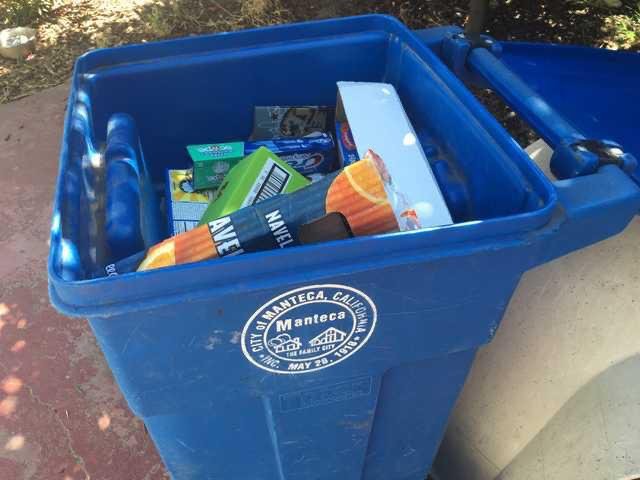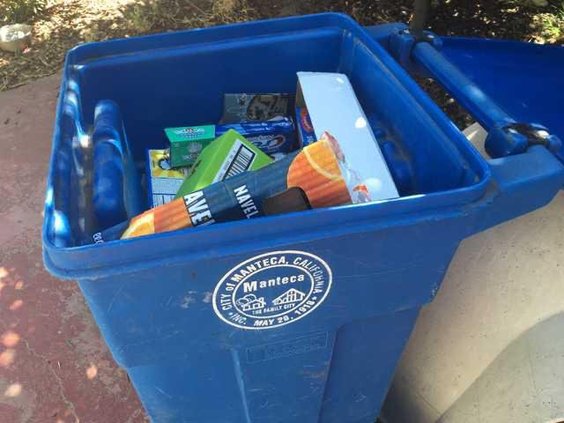Among the things we did during the first week after we moved into the house we bought on Pine Street in a 1950s era neighborhood between Doctors Hospital and downtown Manteca was pull out shrubs.
And I don’t mean a few.
There was a brick flower bed around the side and front of the house.
It was jammed with low-maintenance, dull-looking spruce shrubs.
They had to go.
It took the better part of 8 hours with the help of my brother-in-law to pull them out roots.
I realized we had a real problem when we finished
How was I going to get rid of the yard waste?
All we had was two 32-gallon metal garbage cans.
They were the type a young John Harris — who went on to become a probation officer and eventually served 12 years on the Manteca City Council — used to dump into garbage trucks as part of a summer job he had as a teen with the city.
A neighborhood said it was no big deal.
Just secure them in 32-gallon plastic garbage bags, put them next to the garbage cans on collection day, and the city would haul them away.
I followed his advice.
When I had finished there were 42 garbage bags ready to go curbside on collection day.
The city garbage truck crew dutifully tossed all of the bags into the truck as well as dumping the garbage cans.
Although they repeatedly told us it was city policy to do so, we were so grateful to get rid of the yard rubbish that we insisted they take a six-pack of Pepsi we had bought to thank them.
That was back in 1993, just after the city added the blue and green containers to place recyclables in.
Two years later, the city switched to the present cart system using a brand name known as Toters.
The name is important to note.
The reason is simple.
It’s because of the Toter Wars
They were so named by a council member fed up with what had become a Manteca pastime overnight — lodging complaints with elected officials and city hall when people left their Toters in plain view of the street on non-collection days.
It was a violation of Manteca’s municipal code.
And like most other violations of city laws, the Toter rules were enforced only when a complaint targeting a specific address was made.
The Toters were three times the size of garbage cans that were either metal or high-impact rubber cans.
And they popped out in colors of blue, green, and brown as opposed to the dullish tin gray of the metal cans.
More than a few people when the city switched to the Toters would leave them in the driveway all week or just outside a side yard gate.
It got to the point that one resident who was repeatedly cited ended up being hauled before a judge.
The homeowner was less than thrilled to hear the judge tell him the city could legally dictate where not to put his Toters and in what days.
What finally ended the Toter Wars that lasted with various degrees of intensity over a decade was the city adopting a suggestion advanced by then Councilman Jack Snyder.
Seniors Helping Area Residents and Police volunteers followed garbage trucks on collection day and attached flyers to Toters.
The flyers advised people of the city law and the fact they would be cited and fined if they did not comply.
Then the following week code enforcement officers, the day after neighborhoods had their garbage collected, cited those that still had their carts out.
Blanket enforcement rather than by the “Rat Think Method” brought the neighborhood Toter hostilities to an end.
The Toter Era was when the city also had unlimited green cart collection as long as weight limits weren’t exceeded and chopped up branches didn’t exceed a certain length.
There were more than a few households with two green Toters and even one that topped out at six.
And in most cases, they were placed curbside every two weeks and were almost always full.
We happened to be a household with four green Toters.
Remember that low-maintenance shrubbery we ripped out?
They were replaced with roses.
So was other areas once considered low maintenance.
Between the back, side and front yards we ended up with 168 rose bushes.
Did I mention I can have a tendency to get carried away when I get into something?
We also had inherited a number of fruit trees, had a vegetable garden and couldn’t resist taking out trees and replacing them.
That was in addition to assorted other shrubs and flowers. And that was on top of plenty of lawn area on the quarter acre lot we had that also featured two gigantic Modesto ash trees.
If you doubt the 168 roses or the never ending yard/garden alterations, just ask Tim Bowers.
He’s a neighbor who still lives in the neighborhood.
Bowers dubbed our place “the Winchester mystery yard.”
The city encouraged extra green waste carts at the time at no additional charge because it actually served a purpose.
The State of California back then was keeping track of landfill diversions by weight only and not the type of material involved.
The more tonnage the city could report diverting, the higher its compliance to state solid waste requirements.
And using green waste containers without breathing holes was ideal for lawn clippings and other vegetation to retain their water weight.
As a result, Manteca — and a lot of other cities — seemed to have high compliance rates.
Those days are long gone given the state is no longer fooling itself, at least in what they do when it comes to addressing solid waste, recycling, and landfill diversions.
What brings this up, or course, is the announced move by the City of Manteca that all three carts — green, blue and brown — will be collected on a weekly basis starting the week of Dec. 2.
It will mark the third major shift in how the city collects garbage in the past 34 years.
And you can argue the changes, including this one, work better for households in terms of being able to get rid of the waste they create as well as for the environment.
This column is the opinion of editor, Dennis Wyatt, and does not necessarily represent the opinions of The Bulletin or 209 Multimedia. He can be reached at dwyatt@mantecabulletin.com






